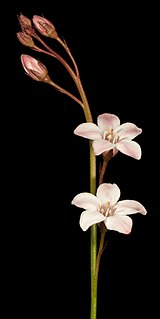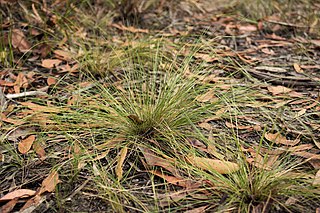
Aristida is a very nearly cosmopolitan genus of plants in the grass family. Aristida is distinguished by having three awns (bristles) on each lemma of each floret. The genus includes about 300 species found worldwide, often in arid warm regions. This genus is among those colloquially called three-awnswiregrasses, speargrasses and needlegrasses. The name Aristida is derived from the Latin "arista", meaning "awn".

Dampiera stricta commonly known as blue dampiera, is a flowering plant in the family Goodeniaceae. It is a small sub-shrub with variable leaves and mostly blue, mauve or purple flowers.

Grevillea pteridifolia is a species of Grevillea native to Australia. Common names include silky grevillea, Darwin silky oak, ferny-leaved silky oak, fern-leaved grevillea, golden grevillea, golden tree and golden parrot tree. It occurs in Western Australia, Northern Territory, and Queensland.

Hakea undulata, commonly known as wavy-leaved hakea, is a flowering plant in the family Proteaceae and is endemic to the south-west of Western Australia. It has stiff wavy leaves and fragrant cream-white flowers from mid-winter to October.

Hakea denticulata, commonly known as stinking Roger is a shrub tree endemic southern Western Australia. One of the many species of Australian plant described by the botanist Robert Brown. A compact shrub 1–2 m (3–7 ft) high and wide with red flowers in the spring with an unpleasant odour.

Conostylis aculeata, commonly known as prickly conostylis, is a flowering, tufted perennial plant in the family Haemodoraceae. It has flat leaves and yellow, hairy, tubular flowers. It is endemic to the south-west of Western Australia.

Synaphea spinulosa is a species of small shrub in the flowering plant family Proteaceae. It is endemic to Western Australia. Together with Acacia truncata, it was the first Australian endemic to be scientifically described and named, and the specimen upon which that description is based is the oldest extant specimen of an Australian plant, and very likely among the first Australian plant specimens ever collected.

Hakea elliptica, commonly known as the oval-leaf hakea, is a shrub in the family Proteacea and is endemic to Western Australia. A fast growing adaptable species with ornamental wavy leaves, golden bronze new growth and an abundance of showy white flowers. A good wildlife habitat due to its dense form with foliage to ground level.
Hakea ilicifolia is an open shrub or tree in the family Proteacea and is endemic to Western Australia. It is a small, dense shrub with stiff, lobed leaves and clusters of yellow or creamy-white flowers.

Hakea linearis is a shrub or tree in the family Proteacea and is endemic to Western Australia. It has smooth branches, mostly linear leaves and white flowers.

Petrophile teretifolia is a species of flowering plant in the family Proteaceae and is endemic to southwestern Western Australia. It is a shrub with needle-shaped but blunt-pointed leaves, and oval to more or less spherical heads of hairy pink to mauve flowers.

Aristida contorta, commonly known as bunched kerosene grass, kerosene grass, bunched windgrass, silvergrass, mulga grass,sand speargrass, and medicine grass, is a species of grass in the family Poaceae that is native in Australia. The Walmajarri name for this species is Ngirrirli.

Aristida calycina, commonly known as dark wiregrass, is a species of grass in the family Poaceae that is native in Australia.

Samolus junceus in the family Primulaceae is a species of water pimpernel native to Western Australia.

Westringia rigida is a shrub in the Lamiaceae family that is endemic to Australia. and

Phlebocarya ciliata is a plant in the Haemodoraceae family, native to Western Australia.

Scaevola striata, commonly known as royal robe, is a species of flowering plant in the family Goodeniaceae. It has blue fan-shaped flowers, and is endemic to Western Australia.

Dampiera incana, commonly known as the hoary dampiera, is a flowering plant in the family Goodeniaceae and is endemic to Western Australia. It is a perennial herb with grey foliage and blue-purple flowers.

Aristida warburgii is a species of grass that is native to New South Wales and Queensland. It was first described by Carl Christian Mez in 1921 from a specimen collected near Maryborough, Queensland. The species epithet, warburgii, honours Otto Warburg.
Alternanthera angustifolia is a small herb in family Amaranthaceae found widely in inland Australia from northern Western Australia, the Northern Territory, South Australia, New South Wales to Queensland.



















